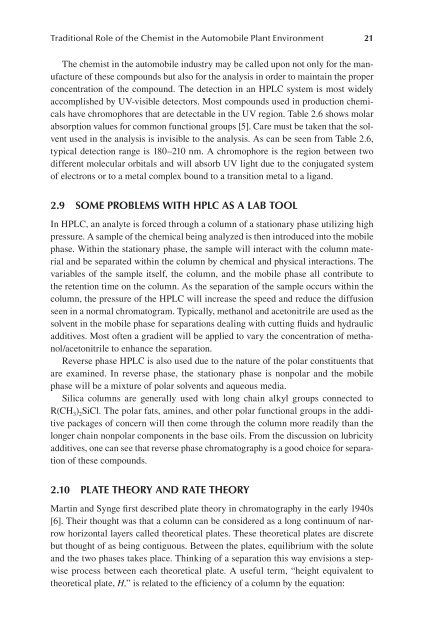THE ROLE OF THE
THE ROLE OF THE
THE ROLE OF THE
Create successful ePaper yourself
Turn your PDF publications into a flip-book with our unique Google optimized e-Paper software.
Traditional Role of the Chemist in the Automobile Plant Environment 21<br />
The chemist in the automobile industry may be called upon not only for the manufacture<br />
of these compounds but also for the analysis in order to maintain the proper<br />
concentration of the compound. The detection in an HPLC system is most widely<br />
accomplished by UV-visible detectors. Most compounds used in production chemicals<br />
have chromophores that are detectable in the UV region. Table 2.6 shows molar<br />
absorption values for common functional groups [5]. Care must be taken that the solvent<br />
used in the analysis is invisible to the analysis. As can be seen from Table 2.6,<br />
typical detection range is 180–210 nm. A chromophore is the region between two<br />
different molecular orbitals and will absorb UV light due to the conjugated system<br />
of electrons or to a metal complex bound to a transition metal to a ligand.<br />
2.9 some Problems wItH HPlc as a lab tool<br />
In HPLC, an analyte is forced through a column of a stationary phase utilizing high<br />
pressure. A sample of the chemical being analyzed is then introduced into the mobile<br />
phase. Within the stationary phase, the sample will interact with the column material<br />
and be separated within the column by chemical and physical interactions. The<br />
variables of the sample itself, the column, and the mobile phase all contribute to<br />
the retention time on the column. As the separation of the sample occurs within the<br />
column, the pressure of the HPLC will increase the speed and reduce the diffusion<br />
seen in a normal chromatogram. Typically, methanol and acetonitrile are used as the<br />
solvent in the mobile phase for separations dealing with cutting fluids and hydraulic<br />
additives. Most often a gradient will be applied to vary the concentration of methanol/acetonitrile<br />
to enhance the separation.<br />
Reverse phase HPLC is also used due to the nature of the polar constituents that<br />
are examined. In reverse phase, the stationary phase is nonpolar and the mobile<br />
phase will be a mixture of polar solvents and aqueous media.<br />
Silica columns are generally used with long chain alkyl groups connected to<br />
R(CH 3) 2SiCl. The polar fats, amines, and other polar functional groups in the additive<br />
packages of concern will then come through the column more readily than the<br />
longer chain nonpolar components in the base oils. From the discussion on lubricity<br />
additives, one can see that reverse phase chromatography is a good choice for separation<br />
of these compounds.<br />
2.10 Plate tHeory and rate tHeory<br />
Martin and Synge first described plate theory in chromatography in the early 1940s<br />
[6]. Their thought was that a column can be considered as a long continuum of narrow<br />
horizontal layers called theoretical plates. These theoretical plates are discrete<br />
but thought of as being contiguous. Between the plates, equilibrium with the solute<br />
and the two phases takes place. Thinking of a separation this way envisions a stepwise<br />
process between each theoretical plate. A useful term, “height equivalent to<br />
theoretical plate, H,” is related to the efficiency of a column by the equation:







